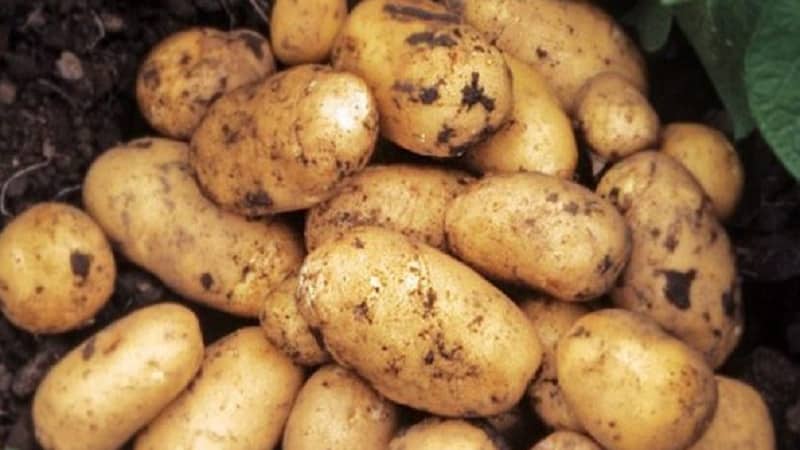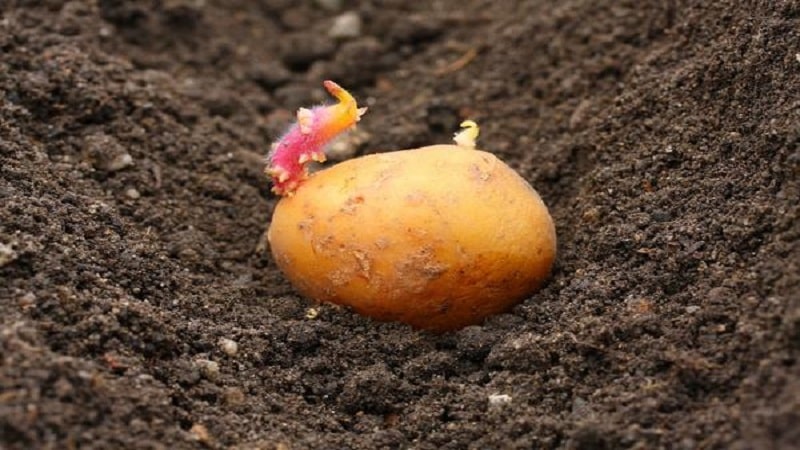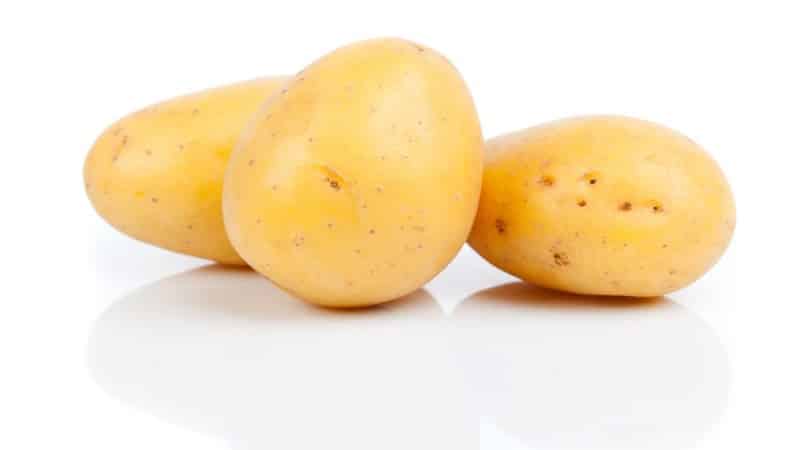Early low-growing potato variety "Juvel" from Germany
Ultra-early German variety Jewell potatoes are suitable for cultivation in all regions of the country. In the southern regions, if desired, you can harvest twice. Compact low-growing bushes take up little space, ensuring economical use of the site. The culture has stable immunity to most diseases and is highly productive.
In the article we will talk about the rules of growing potatoes, methods of preventing fungal infections, combating wireworm larvae, the advantages and disadvantages of the variety.
Description of the variety and its origin
The Juwel variety was developed by breeders from the German company Bavaria-Saat GbR, which unites several seed-growing enterprises. In 2003, the Bavaria-Saat Vertriebs GmbH partnership was founded, whose activities are aimed at selling seeds in Germany and neighboring countries. The active work of the company contributed to the popularization of this potato variety in the EU countries, the Russian Federation, Belarus and Ukraine.
The variety is still not included in the State Register of Russia, but is popular in many regions. In the southern regions, it is harvested twice.
The culture is characterized by ultra-early ripening, rapid growth and a short growing season. The plant adapts to any climatic conditions and soil quality.
Pictured are Juwel potatoes.

The distinctive features of potatoes are presented in the table.
| Indicators | Characteristic |
| Ripening period | 50-60 days |
| Bush | Low, intermediate, erect or semi-erect |
| Number of tubers in a bush | 15-20 pcs. |
| Weight | 80-150 g |
| Form | Oval, slightly elongated, with a smooth surface without tubercles |
| Coloring | Yellow peel and pulp |
| Leaves | Medium size, dark green, with slight wavy edges |
| Corolla color | Violet |
| Starch content | 10-15%. |
| Taste | Average |
| Cooking class/group | Culinary type B (medium crumbly) |
| Productivity | 450 c/ha during the first digging, 750 c/ha during the next one |
| Marketability | 94% |
| Keeping quality | 95% |
| Purpose | Dining room |
| Sustainability | High - to scab, cancer, tuber rot, nematode, medium - to late blight of tops |
| Transportability | High |
Potato agricultural technology
The technology for growing the Jewel variety is standard and involves germination of tubers, timely planting, loosening, weeding and the application of organic and mineral fertilizers.
Dates, scheme and rules of planting
Jewel potatoes feel great on any type of soil, provided that organic matter and minerals are added. 20-30 days before planting, the tubers are prepared for germination. Seed potatoes are removed from the cellar, sorted and disinfected in copper sulfate (1 matchbox of powder, 1 g of potassium permanganate/10 l of water) or Fitosporin.

Another way to process potatoes before sprouting:
- 40 g urea;
- 60 superphosphate;
- 10 g boric acid;
- 5 g copper sulfate;
- 1 g potassium permanganate;
- 10 liters of hot water (80°C).
The components are mixed in an enamel bowl and, after cooling, the tubers are soaked in the solution for 15-20 minutes. Then the material is laid out in one layer on a flat surface to dry.
Important! The soil for planting is prepared in the fall: they dig up and plant wheat or mustard. After a month, they are mowed and buried in the ground.Green manure increases the nutritional value of the soil and prevents the growth of fungi and bacteria.
Holes with a depth of 20 cm are formed on the site with an interval of 25-30 cm. The distance between the rows is 50-70 cm. 150-20 g of wood ash are poured into each hole. Small tubers are buried whole in the ground, large ones are cut in half and the cut is sprinkled with ash.
Care
Rules for caring for plantings:
- Watering is carried out as the soil dries once a week. In hot weather, the frequency of watering is increased to 2-3 times.
- After moistening, the soil is loosened to prevent the formation of a dense crust and saturate the root system with air.
- The bushes are earthed up as soon as the height reaches 15 cm. Then the manipulation is repeated after flowering. This promotes the formation of more tubers. At the same time, weeding is carried out.
- For feeding, manure and mineral fertilizers with potassium, phosphorus and magnesium are used. The first root portion is applied 30 days before planting (manure or chicken droppings), the second foliar portion is applied after flowering. To accelerate the formation of tubers, growth stimulants are used - “Epin”, “Gibbersib”.
Potato producer Jewel recommends applying nitrogen fertilizers in minimal quantities (up to 140 kg/ha). Excess nitrogen inhibits the development of tubers, impairs taste, and accelerates the growth of tops.
Potassium complexes are applied in the amount of 150-300 kg/ha, phosphorus fertilizers - 100 kg/ha. Magnesium fertilization is carried out in an amount of 60-80 kg/ha. The dosage is adjusted depending on the growing region and soil composition.
Organic fertilizer options:
- 500 g mullein, 20 urea/10 l warm water;
- 1 tbsp. l. dry chicken manure/10 liters of water.
Options for mineral supplements:
- Dissolve 15 g of potassium sulfate with the same amount of double superphosphate in 10 liters of water;
- 100 g superphosphate/10 l water (use for spraying);
- 50 g of fresh yeast, 50 g of sugar/10 l of water, leave for 2 hours and add water 1:5 (the solution contains magnesium, zinc, boron, iron);
- 200 g urea, 10 g boric acid/10 l (solution for spraying bushes).
The content of surfactants (surfactants) in ready-made fertilizers promotes the rapid penetration of minerals into the plant.
Nuances of cultivation and possible difficulties
Another method is used for planting potatoes - without digging the soil. The tubers are planted directly onto the turf and covered with a thick layer of mulch (hay, straw, sawdust, peat). This method is also called natural due to the fact that the tubers grow not on the root, but on stolons (a quickly dying side shoot with underdeveloped leaves, elongated internodes and axillary buds). No land is required for this. The main task is to provide the plant with nutritional components by introducing complex compounds.
Even beginners do not have any difficulties with growing the Jewel variety. Potatoes are planted even in insufficiently warmed soil. The culture withstands light frosts.
Important! When watering the bushes, keep in mind that excess moisture negatively affects the taste of potatoes. The fruits become watery and insipid. To control moisture, a drip irrigation system is installed on the site.
The crop grows on any soil, but to increase fertility, experienced farmers recommend using Agromax fertilizer. It contains humic acids, bioactive water and blood meal.All this contributes to the strengthening of plants, the growth of beneficial microorganisms in the soil, and the saturation of cells with nutrients.
Diseases and pests
Thanks to ultra-early ripening, potatoes have time to bloom and form tubers before the massive spread of late blight spores and Colorado potato beetle larvae that infect the crop in mid-summer.
To prevent diseases, tubers are treated with potassium permanganate, boric acid or Fitosporin before planting.. The bushes are sprayed with a 1% solution of Bordeaux mixture or copper sulfate (20 g/10 l), with Silk and Krezacin preparations.
The culture has strong immunity to scab, cancer, tuber rot, and golden nematode.
The voracious wireworm larvae pose a danger to the future harvest.
Signs of damage:
- through holes in the fruit and dark depressions on the peel;
- wilting of bushes;
- detection of larvae when working in the garden.
Preventive measures:
- competent crop rotation;
- timely harvesting;
- reducing soil acidity;
- attracting click beetles, ground beetles, starlings, crows, blackbirds, doves, rooks, wagtails, and tits to the site;
- weeding.
Fighting methods:
- sprinkle the beds with ground eggshells;
- prepare a solution of 500 g of nettle tincture/10 liters of water and fill the holes before planting, then treat the beds 2-3 times for 7 days;
- add 30 g of ammonium nitrate per 1 m²;
- water the bushes with a weak solution of potassium permanganate at the root;
- treat the plantings with Decis, Actellik, and Barguzin.
Collection, storage and use of crops

The first harvest is dug up in the last ten days of June when tubers are planted in the early stages (April-early May). When planted late, potatoes ripen 1-2 months later.Harvesting in June allows you to make up for the shortage of products in the off-season.
The peculiarity of the variety is the loss of taste and presentation during long-term storage. This is due to the early ripening period. A high-quality harvest can be preserved in the cellar until November.
Before digging potatoes, dry tops are cut and burned. Harvesting is carried out in dry sunny weather, sorted and dried in a dark room for 3-4 days. Then the tubers are placed in boxes or bags and stored in a cool room.
Reference. Potatoes are best stored together with beets, which are placed on top. Root vegetables absorb excess moisture and prevent rotting.
On a balcony or loggia, potatoes are stored in homemade double boxes inserted into each other like a nesting doll. The space is filled with polystyrene foam or dry sawdust. Tubers are periodically sorted, spoiled and green ones are thrown away.
Potatoes are suitable for boiling, baking, frying, and making soups. During heat treatment, it retains its structure and does not fall apart.
Due to their low starch content, the tubers are not suitable for pureeing, but when fried or baked, a crispy crust forms on the surface.
Advantages and disadvantages of the variety
Advantages:
- early ripeness;
- high productivity;
- the opportunity to get two harvests when cultivated in the southern regions of the country;
- attractive appearance;
- possibility of transportation over long distances;
- disease resistance;
- drought resistance;
- undemanding to the composition of the soil;
- When damaged, the wounds heal quickly.
Flaws:
- average taste;
- watery structure and bland taste with excess moisture;
- short shelf life.
Farmer reviews
Reviews about the Juwel variety are mostly positive. The crop attracts the attention of farmers due to its early ripening, high productivity and resistance to most diseases.
Lyudmila, Cheremisinovo: “I’ve been growing potatoes for three years in a row. The bushes bloom in a beautiful purple color. I plant early and harvest twice - in June and September. This is an excellent early variety that is not afraid of drought, the Colorado potato beetle and late blight. Young potatoes with dill and butter are especially tasty.”
Larisa, Kantemirovka: “I grow Jewel for my own needs in order to obtain early potatoes. I start planting in April, by which time the soil in our region has time to warm up a little. I do the digging in mid-June. Not suitable for long-term storage. I water the bushes moderately so that the tubers are not too watery. I feed with manure before planting, and then once with superphosphate.”
Andrey, Salsk: “I first tried to plant this variety the year before last. I liked the result, so I decided to start growing potatoes for sale. The taste is not bad, it is important not to overwater the bushes, otherwise the tubers will be watery and insipid. The early ripeness of the crop allows harvesting in June. The plant is unpretentious in care and responds well to mineral supplements.”
Read also:
The most effective recipes for potato eye masks.
Do potatoes cause gas and why does it make your stomach swell?
The benefits and harms of boiled potatoes for the human body.
Conclusion
The Jewel variety is one of the high-yielding crops. If you follow the rules of agricultural technology, you can harvest about 750 kg of selected potatoes from one hectare.Early ripening allows you to harvest before late blight and the Colorado potato beetle begin to spread. Preventive treatment of planting material in potassium permanganate, copper sulfate, and Fitosporin prevents infection by fungi.
Crop rotation, timely weeding and control of soil acidity help protect plantings from wireworm larvae. The culture is undemanding to soil composition and climatic conditions. To increase productivity on poor soils, organic and mineral fertilizers are applied, green manure is sown, and Agromax fertilizer is used.